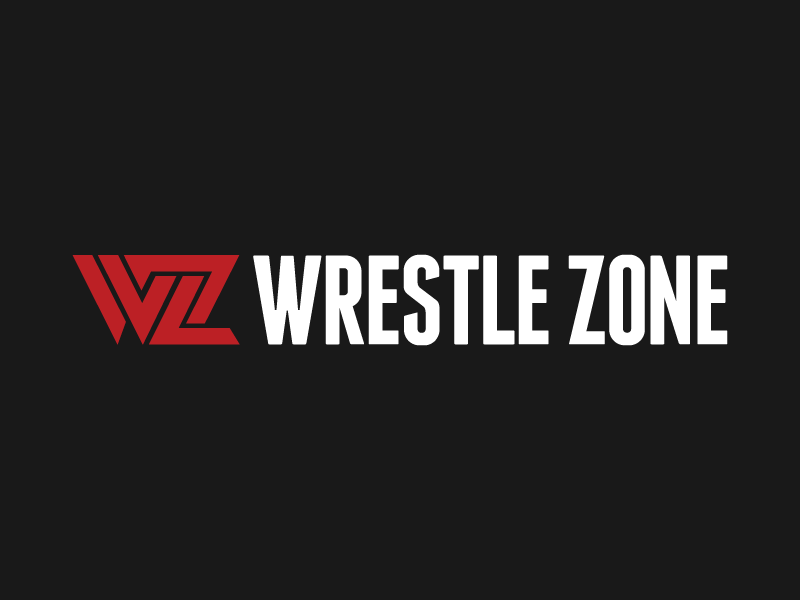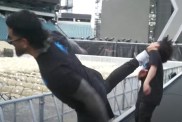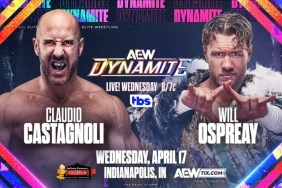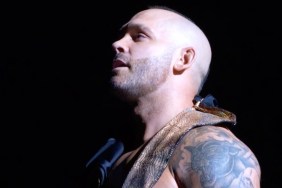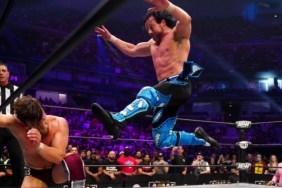This is one of the few columns that I’ve written twice, because I was displeased with the first copy I did.
Let’s hope this one works out better.
Before I begin, some of you might be noticing the change in graphical presentation. I’ve decided to abandon the black background/white text format because some of the sites and some of my readers just aren’t finding it compatible with their software and/or tastes. I liked it, but it’s time to bid it a fond farewell.
Anyways, jumping right to it, because my personal life is none of your damn business, I want to talk about something that has been bothering me in the IWC lately.
One of the common misconceptions held in the world of Internet Wrestling Fans is that we, merely by virtue of belonging to this community, understand the subtle nuances of wrestling. It’s a blanket issue, and rather than tackle the whole thing, I’ve decided to talk about my current IWC Pet Peeve.
The misconceptions about Ring Psychology abound… I’m not saying that people can’t agree over who uses ring psychology well and who doesn’t, I’m talking about the fact that the vast majority of people who gather on these forums and groups have no earthly idea what the words “Ring Psychology” mean.
I’m going to give (most of) you the benefit of the doubt, and skip over the definition of “Ring”. It’s the psychology portent of the term that we’re going to be focusing on.
My current issue with the way the people at large on the internet define the term is that they limit it, cripplingly so, to “Working a body part before putting on a submission.” And it is by this definition alone that great hand psychologists like Kurt Angle and Steve Austin are dismissed out of hand. The do not meet the limited criteria of the (horrendously) under qualified judges.
Ring Psychology is an “Insider” term that has slowly leaked out. No books have provided a real definition of it, unlike other industry terms like “Mark”, “Smark”, “Potatoed”, “Stiff”, “work”, “kayfabe”, “Babyface” and “heel”.
In the end, we’re so familiar with the majority of the terms that those within the business use on a regular basis, we’ve adopted them into our communal lexicon, that we’ve just brought the term “Ring Psychology” right in with it. The problem is, we hear the term, but not what the actual wrestlers are saying as they use it.
Let me provide an example of this. The film “Beyond the Mat” talks about someone many consider to be one of the greatest Ring Psychologists ever, Jake the Snake Roberts. They talk about how he spoke to the audience, how he brought them into the match and sold not the moves but the story and the drama of what he was doing. Jake never “worked” a body part, and in fact, he was a fairly sub-par worker to begin with, but he had a mastery of the audience, he knew how to captivate and ‘entrance’ them.
Don’t confuse what I’m saying though, that’s not exactly what Ring Psychology is about, it’s merely one of the aspects.
Ring Psychology, whether or good or bad, covers everything that is done in the ring. The whole point of it is to draw the audience into what you’re doing, be it via promo or ring work. The whole point is to sell the crowd on the fact that what you’re doing is, or could be, real. It’s an avenue for the suspension of disbelief. Sure, we know it’s fake, but we want to, at least while we’re watching, believe that maybe what’s happening is legit. It’s not a logical thing, but at the same time, it’s what we want to do with all ‘fiction’ on television. When we’re watching Friends (and I use Friends not because I watch it, but because everyone knows who the characters are), you don’t say “That Matthew Perry sure delivers his lines with humorous timing!” No, you say “Chandler’s a funny guy! Change the channel ass-wipe.” We know that these guys don’t really live in these apartments; we know that Ross and Rachel never really dated, and that Monica is really married to (Former WCW World Champion) David Arquette. It’s a set, they’re actors, and they have lives beyond what we see on that one half hour a week (or now that it’s syndicated, nineteen hours per day). It’s about pacing the match, building the drama. It’s about selling the strength of the Big Show, the fact that the Undertaker is dead, that Austin hates his boss and that Eugene is truly a savant, and not an actor named Nick playing a difficult part. It’s about making a suplex real, a submission legit, and the climax of the match feel right.
I consider a lot of guys that don’t normally make people’s “best workers” list to be phenomenal ring psychologists, not because they share the same skills, but because they know how to play to their strengths and make us enjoy and, in a way, believe what it is that they want us to believe and enjoy.
A perfect example of this is Steve Austin vs. The Rock at Wrestlemania X7, when they met in what I consider to be the greatest Wrestlemania match of all time. Others will clearly tout the Steamboat/Savage class at Wrestlemania 3, Traditionalists will talk about Hogan and Andre, and fans of the technical style will talk about Shawn Michaels and Bret Hart, and I readily admit that those are all great matches, worthy of being called the best, depending on your criteria, but for me, nothing tops Austin and the Rock. Both characters were at the height of their popularity, and the WWE(F at the time) didn’t give anything away, and made as really want to see the clash. I still think about the match every time I hear “My Way” by Limp Bizkit, because the black and white videos they played while the theme song was used (the first use of licensed music to promote a match that I can remember), and the way it fit with the dichotomy of the characters. The clash itself was epic, it wasn’t a technical masterpiece, but it was a back and forth brawl, one which swayed the allegiances of the fans in attendance and at home several times as you watched. The finish, with Austin kicking out of the Rock Bottom and the Rock kicking out of the Stone Cold Stunner has caught on for a while as a fad, with everyone kicking out of each other’s ‘devastating’ finishers. So much so, that people forget the impact of it at the time. Up until that point, the Stunner was the end of a match. The move in itself was a great device, as it came out of nowhere and fit the character of Steve Austin very well. People exploded when the Rock kicked out, get a tape and listen to it, close your eyes and hear the call, and then seconds afterwards you can hear the roar of the crowd, a roar of disbelief.
THAT is ring psychology, using your bodies to tell a story so well that the fans, the people who’ve paid to see what you’re about to do, erupt, as they can no longer contain their excitement. The suspense and thrill of the whole thing, if there is one moment in time where I would like to front row at a WWE/F show, that would be it right there.
So when people tell me that Kurt Angle is a good worker, but then they go on to say that he’s got no Ring Psychology, I ask them how it is that they figure that. The answer is always the same, he never ‘works the ankle’ before slapping on the Ankle lock.
I have this conversation over the internet, so any attempt to slap the person who says(types) this to me is more or less futile, but believe me when I say that I want to. I want to so much it hurts (specifically, it hurts my hand where I’ve slapped the corner of my monitor)
I want to yell and shake the stupid right out of them, shake them like I’ve found the one spot in the house where the Nanny Cam can’t see me. Get a friend, lie down on your stomach, and tell him to grab your ankle and just start jerking and twisting it around. Then ask yourself how the hell you could be so stupid to let your friend do this. It f’ing hurts, and your ankle was just fine before he started twisting on it. If it’s realism you want, there it is, proof that you don’t need to “work” a body part before putting a hold on it. Sure, it can be an aspect of Ring Psychology, but working a body part doesn’t lead to the “submission” being believable, it’s about building up the fact that you’re going to DO the submission hold itself. You’re building anticipation, it’s the “rising action” of any good plot. It’s not a necessary component of Ring Psychology, it’s merely an aspect of it, a potential way to use it. Kurt accomplishes the same basic thing when he gets his “wild eyes” going, pulls the straps down, and stalks his intended victim. The feeling gets across the audience.
Kurt is a fantastic psychologist; he does a lot of small things that people just don’t notice. The way he stays low to the ground, his stance… The fact that he almost never hits the ropes or Irish whips his opponent, the way he knows when to pick his spots and when to get thrown around. People who write him off based on the fact that he doesn’t meet their limited definition are robbing themselves, out of ignorance, of a great performance. I suspect that, and this is a little amateur psychology, that they’re jealous of Kurt Angle. The resent the fact that he’s a true total package performer. There’s no doubt that most of us “fans” would very much like to be wrestlers, and we largely consider ourselves capable of it. Part of us realizes that, even if we could do it, the odds of us being as good at everything that Angle is are very, very slim. So we put him down, so we purposely limit him in our communal definitions so that we can feel a little better about the fact that we have limitations.
Since I’ve made my point a little more quickly than usual, I’m going to offer up a bit of a bonus feature to those who would like to read a little more. It’s just a list of guys I consider to be fairly top-notch ring psychologists that you may or may not have considered.
Ric Flair
Ric Flair gets touted as an extremely technical wrestler, and that’s fairly false. He’s got a decent move set, but this comes mostly from the fact that he’s finisher is a submission hold. Ric Flair is in fact an average in ring worker, (Sacrilege, I know), but he is a phenomenal Ring Psychologist. Ric Flair toured the country, in the heyday of the NWA, defending his title in every town, every night, for years. Ric Flair was great not because of how good he was in the ring, but for how good he was capable of making his opponents look. Everyone looked great against Ric Flair, they even say (in the locker room) that he could wrestle a broom and still turn out a five star match. He told a story with his body, with his bumps and with his cheating. His promos were fantastic, all the time, but it’s the way he knew to pace a match, when to hit the high spots, when to bump, and in the end, when and how to sneak away with his title intact while making the challenger, the local hero, look like he was better than Ric Flair. That’s what he did, he went town to town and made the guys he was wrestling look like they should have and deserved to win. It’s a shame there aren’t more tapes of this, more records of just how good Ric Flair was, just how good he held the audience in the palm of his hand.
Rowdy Roddy Piper
One of the best never to win the championship, which isn’t really a bad thing… Old Rowdy Rod had one job in the WWF, one purpose and goal, and he did it better than anyone had ever done. Your job was to hate him, and to want badly to see him get beat. He was the foil to Hulk Hogan’s unbeatable super-man, he was the devious, violent, ill tempered coward. He was Lex Luthor, he wasn’t supposed to win, that wasn’t his job. He was supposed to taunt and cheat and bluster, and then in the end get what he deserved. Lord, everything he did was perfect, but nothing beats the time he spent on the mic, nothing tops the intensity and the fury that this relatively small man had in him. I love watching Piper talk, more than I love Austin, Flair and even the enigmatic (and somewhat gibbering) Snuka combined. Piper was something else, and it’s a real shame to see how Vince holds a grudge against independent thought. Piper spoke his mind and lost his job for it. It could have been used much to the WWE’s benefit, but instead they just swept Mr. Piper under the rug, and that was the end of it.
Hulk Hogan
I know, I know, I’ve ripped on Hogan before; he’s a terrible worker and a politician backstage… But he also set the bar so high for the connection he made with the fans that only a few have ever been able to reach the heights he did. (Namely Austin and The Rock)
Hogan spoke to the fans, he was the first to interact with them, to encourage them as he was “working” to voice their opinions. He made it seem as if they were the ones bringing him back from the brink of defeat every night.
Sure, it’s common now, every time someone’s in a sleeper hold, the fans “snap him out of it.”
“He’s feeding off the energy of the fans!” JR yells, and the that one, wavering arm wobbles unsteadily into the air, the fans react, and the elbows to the gut sell the release from the sleeper hold and herald the coming come back.
But… And this is a big but, Hogan was the first to do this, he was the first to really encourage this, and it was fairly revolutionary at the time… And the fans ate it up, ate it up to the tune of millions of dollars and the national expansion of the whole industry. Working with Hogan was, to the boys, their shot at a huge main-event payday, because that’s what the fans wanted. They wanted to interact, they wanted to cheer for their yellow speedo clad super-hero, and that, like it or not, is applied psychology.
(Though, to be fair, I believe Verne Gagne is responsible for it, as he kept telling Hogan to show off his muscles during the match.)
And lastly, and most controversially,
The Rock
Oh man, the Rock is my favorite “Ring Psychologist” of all time. You can’t reasonably say he’s the best or not, that’s subjective, but boy-o-boy was his approach to the whole thing unique.
Rock was the picture perfect heel, the corporate champion, with the expensive shades and shirt and shoes… Everything he did, the snap in every mood, the tone in every word, the way he spoke in the third person, the way he gestured, the eyebrow, it was all so delightfully arrogant, so perfect and vile and villainous. I loved watching the corporate Rock, he’s by far my favorite ‘character’ from the Attitude Era. I loved the way he wore his championship belt while he talked, I loved the way he’d adjust the microphone. I loved watching him get ready to fight, as he took off the Rolex, the silk shirt, the gold trimmed shades. He was a shit-talking guy, yeah, but he wasn’t your typical, cowardly heel, he could get it done. And when you watched him wrestle, he didn’t speak to the audience, but he tossed an endless stream of verbal abuse at his opponents.
Lord, that was some good TV.
Of course, he was so good at it, his face turn was inevitable, and while it was enjoyable, it wasn’t the same. Sure, he clung to some of his heel habits, but all of a sudden, beneath it all, he was a good guy. Sure, it was fun to watch him get sick and tired of talking to and working with Foley, and it was great to see him in matches against the top heels instead of faces, and his promos were still top of the line, but he lost something to me when he turned face. He just wasn’t quite as good as he was as a heel.
Oh well, that’s it for this week, a mere five pages, but that’s ok.
Next ‘edition’ of the ringside sermon should, if all things go as planned, be the first part in my next (epic) four part series, “The Impact of ECW.”
Be sure to keep your eyes open for it.
– – – – – – – – – – – – – – – – – – – – – – – –
If you are interested in becoming a columnist or simply love reading wrestling columns and would like to interact with the Column Staff here at WrestleZone please check out the Columns Lounge. Simply click HERE and you can take part in the fun today.
